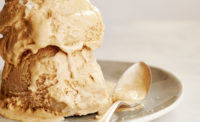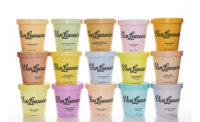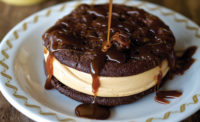
Sometime between Wall Street crumbling and the nation voting in its first African-American president, artisan ice cream makers sprouted up across the country. Some started selling their goods via a single-standing cart in a major metropolis, while others opened up scoop shops or packaged product for distribution through regional natural and specialty foods stores, as well as farmers’ markets and mail order. And despite challenging economic times, Americans seem to be more than willing to dip into their pockets for what many describe as “an affordable luxury,” positioning artisan ice cream as one of the most exciting dairy foods categories of this decade.
Most artisan ice cream marketers agree that consumers understand that handmade and local sourcing equates to a higher cost. Credit the specialty cheese market, which during the 1990s provided a livelihood for numerous cheesemakers who had gone out of business when they were unable to compete with the efficiencies of mega-cheesemaking producers, but showed they could survive - and thrive - when they invested in creating artisan, farmstead and ethnic cheeses.
Don’t nickel and dime the pint
The difference between artisan cheese and ice cream is that cheese varieties are easily sold at a varying price per pound, which is often determined by ingredients, as well as the time and effort that goes into the making of the cheese. When it comes to ice cream, most marketers line price product, which means that all flavors in the same size package retail for the same price. This results in some varieties being profitable, others a wash and some sold at a loss. Though many presume that the “additional” ingredients such as candies, flavors, fruits, nuts and other inclusions drive ice cream manufacturing costs, these days it is often the base ingredients.
According to the latest figures from the U.S. Department of Agriculture, milk prices have gone up about 40% in the past year, while sugar prices are up almost 20%. And though one would think high-fructose corn syrup suppliers would be giving away this highly functional and economical sweetener that received a ridiculous amount of unwarranted negative publicity the past few years, its price, too, has gone up, in fact, more than 20%. Yet, with all of the major ingredients in ice cream costing more, the U.S. Bureau of Labor Statistics says the average price of a half-gallon of ice cream has increased just 7%.
Thus, even as the price of ice cream ingredients continues to go up, most marketers are not passing all of the expense onto consumers in fear of consumer backlash, especially in the retail environment. This is where artisan ice cream makers have some leeway, as they can charge a premium for their first-class offerings while consumers accept the surcharge.
For example, Wholes Foods charges $8.99 for a pint of artisan ice cream manufactured by Chicago-based Nice Cream. The ice cream maker is a big believer in using real foods that promote sustainable and environmentally sound-growing practices and touts the fact that it purchases mostly fresh produce and dairy from farms located within 100 miles of Chicago.

“Another summer ‘11 specialty is Chocolate Basil,” says Swanberg. “Think Chocolate Mint, but a little more adventurous. It includes 72% dark chocolate, which is high in antioxidants, and Chicago-grown freshly picked organic basil leaves.”
In early August in the Pacific Northwest, artisan ice cream maker - Salt & Straw Ice Cream - opened its first scoop shop in downtown Portland, Ore. Until now, the company has marketed its “farm-to-cone ice cream,” which is made by hand in small batches using ingredients from some of Oregon’s best farmers, producers and restaurateurs, as well as a few imported flavors from small, known farms around the world, via a single cart selling scoops and mail order. All ice creams start with high-quality cream from Lochmead Dairy, Junction City, Ore., a fourth-generation dairy whose cows were born right on the farm. The hand-churned ice cream targets a 17% butterfat, with very little overrun, to ensure a creamy texture and thicker bite, according to the company. A single 4-ounce scoop sells for $3.50.
“We opened with our little push cart just over two months ago and feel so lucky to have had such an incredible response,” says Kim Malek, founder and culinary director. Malek explains that the name Salt & Straw is a nod to making ice cream from scratch in the 18th century with pots of cream in a tin pail surrounded by salt and straws. With the scoop shop opening, customers can watch the ice cream makers hard at work creating each flavor by hand.
Signature offerings include Cassia Cinnamon Snickerdoodle, which is made with Red Ape Cinnamon from Eugene, Ore. Three Berry Barbecue is made with Oregon huckleberries, marionberries and raspberries and swirled with a sweet barbecue sauce. Honey Lavender is made with lavender from Red Ridge Farms in the Willamette Valley wine country and honey from Oregon bees. Pear with Blue Cheese uses pears from Truitt Brothers Farms, Salem, Ore., and blue cheese crumbles from Rogue Creamery, Central Point, Ore.
“Ice cream is such a great way to celebrate and bring people together,” says Malek. “You can’t help but smile when you’re reminded of your childhood days of simple pleasures like licking an ice cream cone.”
And those simple pleasures should not be hindered by location, which is why Salt & Straw debuted a mail order business earlier this year. A five-pint variety pack commands $65 and can be shipped anywhere in the United States.
Americans don’t seem to have a problem splurging on Salt & Straw ice cream, which motivated the company to offer a special holiday mail-order pack for that time of year when everyone digs a little deeper into their pockets to get into the spirit of the season. The holiday pack includes innovations such as Bourbon Pecan Pie (fresh pecans, molasses, brown sugar and Oregon whiskey from Stone Barn on Portland’s Distillery Row) and Brown-Bread Stuffing (sweet brown bread, savory local herbs, fresh roasted Oregon chestnuts and tart apricots).

The national, and often at times global leaders, recognize that today’s consumers are drawn to premium ice cream as an affordable luxury.
For example, Nestlé Dreyer’s Ice Cream Co., Oakland, Calif., a part of Nestlé USA, which is owned by Nestlé S.A. of Vevey, Switzerland, takes the Häagen-Dazs brand to a higher level of indulgence with the rollout of several “exclusive” and “limited-edition” flavors. True to the tradition of crafting ice creams made like no other, the brand has taken diverse cues from home and abroad to develop one-of-a-kind creations that delight the senses.
“This year we really focused on flavor experiences when looking for inspiration and ideas,” says Häagen-Dazs brand director Gulbin Hoeberechts. “A slice of holiday pie, a bite of fresh fruit from the orchard, a visit to the ice cream parlor, a trip to India - all of these led to the creation of our 2011 flavors...”
These are: Blueberry Crumble (dense blueberry ice cream loaded with rich, buttery cobbler crust crumbles), Caramel Apple Pie (apple ice cream and diced fresh apple swirled with caramel and chunks of flakey pie crust), Cranberry Pumpkin Spice (pumpkin ice cream balanced with swirls of tart cranberry filling and lightly spiced with cinnamon and nutmeg) and Sweet Chai Latte (aromatic chai tea blended into a rich, creamy ice cream). The company has one flavor exclusive to Wal-Mart stores, which is Spiced Peach Crumble Ice Cream. It is described as peak-flavor peaches that are cooked to perfection, lightly spiced and stirred into sweet cream with nuggets of buttery crust.
It is such out-of-the-bulk-container-thinking that is fueling frozen dessert growth for Kleinpeter Farms Dairy, L.L.C., Baton Rouge, La., which continues to grow its mainstream ice cream (12% butterfat) line and is expanding with some indulgence.
“We are now up to 28 flavors in the mainstream line, all of them incorporating locally produced ingredients,” says Jeff Kleinpeter, president. “And this summer we debuted Crème de le Kleinpeter, a pint line featuring 16% butterfat ice cream and lots of indulgent, and at times, exotic ingredients. For example, Blanche et Blanche is sweet cream ice cream with white chocolate flakes and macadamia nuts. And we feature Louisiana-grown strawberries in the Strawberry Cheesecake with Dark Chocolate Truffles.”
Riding the coattails of the artisanal trend in formulating all types of foods with sea salt, Talenti Gelato e Sorbetto, Dallas, introduced Sea Salt Caramel gelato this summer. The flavor features rich, golden Argentine caramel (dulce de leche) made exclusively for Talenti, complemented by the finest fleur de sel - the prized sea salt from France - and tiny chocolate-covered sea salt caramel truffles.
“The combination of sea salt and caramel has been a favorite amongst top French and American chefs for some time and has become a definite trend,” says Josh Hochschuler, founder and CEO.
He points out some added incentives for consumers to buy Talenti. For one, the gelato contains about 30% less fat than regular ice cream. Further, in addition to its commitment to craftsmanship and sourcing quality ingredients, Talenti strives to be eco-friendly and minimize its impact on the environment.
“Talenti is committed to embracing green business practices and finding new and innovative ways to minimize our impact on the environment,” says Steve Gill, president. “Our new #2 HDPE (high-density polyethylene) lids are just the latest example of this longstanding dedication to eco-friendly practices.” HDPE resin is easier to recycle than the polypropylene used in the original lids, according to Gill. (Read more about Talenti’s packaging in the June Dairy Foods, page 38.)
Nostalgic flavors also continue to bring excitement to the frozen desserts category. Baskin-Robbins, a brand of Dunkin Brands Inc., Canton, Mass., offered scoop store patrons Picnic Punch as August’s feature flavor. This cool, refreshing watermelon- and green apple-flavored (red and green) sherbet swirl is reminiscent of classic hard candies that have always been a summer thirst quencher. Now they take the form of a classic sherbet dessert that is lower in calories than ice cream, but high in satisfaction and flavor, according to the company.
“Sherbet is a classic ice cream alternative for those seeking a lower-calorie frozen dessert,” says Brian O’Mara, vice president of marketing. “Sherbets are wildly popular during the hottest months of the year, and we wanted to deliver a new fruity combination we know our flavor aficionados will enjoy.
“Flavor enthusiasts are always seeking variety and originality in their ice cream and sherbet choices,” adds O’Mara. “The sweet, refreshing watermelon flavor combined with tart and tangy green apple flavor makes for a perfect summertime refresher that we think our guests will love.”
With the summer of 2011 now behind us, frozen dessert formulators should be busy developing next summer’s big hits. And if what ingredient suppliers are saying is true, next summer will be even more dynamic than this year. Remember that better-for-you no longer translates to simply less fat or calories. It includes minimally processed ingredients and those considered green; indulgence and decadence reigns. The end result should be affordable luxuries that keep what is a relatively flat category alive and thriving.
Sidebar
Adding Color One Sparkle at a Time
One of the latest crazes in the baked goods category is edible glitter, sparkles that come in a rainbow of colors, as well as metallic hues. Frozen dessert manufacturers can add excitement to their offerings by using the glitter as an inclusion, and scoop shop operators can offer it as a topping.
The glitter comes in soluble and insoluble forms, with each version serving a different function. The insoluble form, which is based on sodium alginate, provides color specks dispersed throughout the mix. The glitter can function alone, or enhance the flavor of other inclusions. Edible water-soluble films can even be flavored and cut into shapes. For example, imagine red glitter or strawberry shapes dispersed in strawberry ice cream for an iridescent experience.
Soluble glitter, which is based on gum arabic, can be added at the end of the ice cream-making process right before the hard freeze. These specks will dissolve slightly (providing that freeze-thaw is kept to a minimum), bleeding color into the ice cream and delivering a swirl of color to the finished product. Different glitters with different solubility characteristics will help control the amount of color bleeding and therefore the swirl effect. This is similar to the way colors bleed off candies mixed into ice cream.
The glitter can also be applied topically to novelties, in particular the chocolate coating on bars or the exposed ice cream between two sandwich wafers. The pearlescent pigment used in the metallic glitter is limited by FDA to confection applications. Thus candies and coatings with metallic glitter can be topically applied to frozen desserts.
Sidebar
You Say Chocolate…I Say Vanilla
Many consumers know that few treats conjure up a summer day memory as much as a dripping ice cream cone or digging into a sundae after a long day at the beach. But which flavor is always the big debate? Who doesn’t remember standing in front of the counter agonizing over that ever important decision? Well, for Americans, chocolate is the way to go as more than one-fourth (28%) say it is one of their two favorite ice cream flavors followed by vanilla (26%) and cookie dough/cookies and cream (22%). These are some of the results of The Harris Poll of 2,183 adults surveyed online between July 11 and 18, by Harris Interactive, New York.
Different groups have their different favorite flavors. For example, three in 10 Easterners (31%) and Midwesterners (32%) say chocolate is their favorite while three in 10 Southerners (30%) prefer vanilla. Westerners have a close race for top flavor with 22% saying vanilla, 21% saying chocolate and 19% saying cookie dough/cookies and cream and rocky road.
And, of course, there are also political differences in ice cream flavors. One-third of Republicans say chocolate is their favorite flavor (32%), followed by vanilla (28%) and cookie dough/cookies and cream (24%). One-quarter of Democrats, on the other hand, say vanilla is their favorite (26%) followed by chocolate (23%) and then butter pecan/Swiss almond (22%). For Independents, it is chocolate first (30%) followed by cookie dough/cookies and cream (24%) and then vanilla (22%). n


